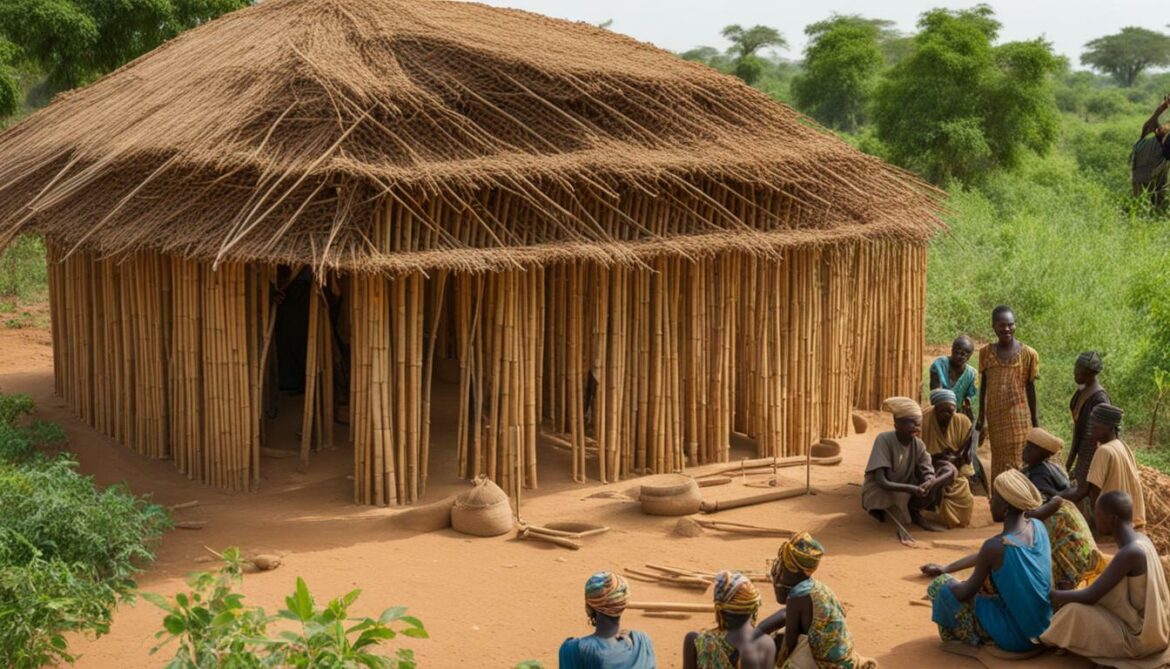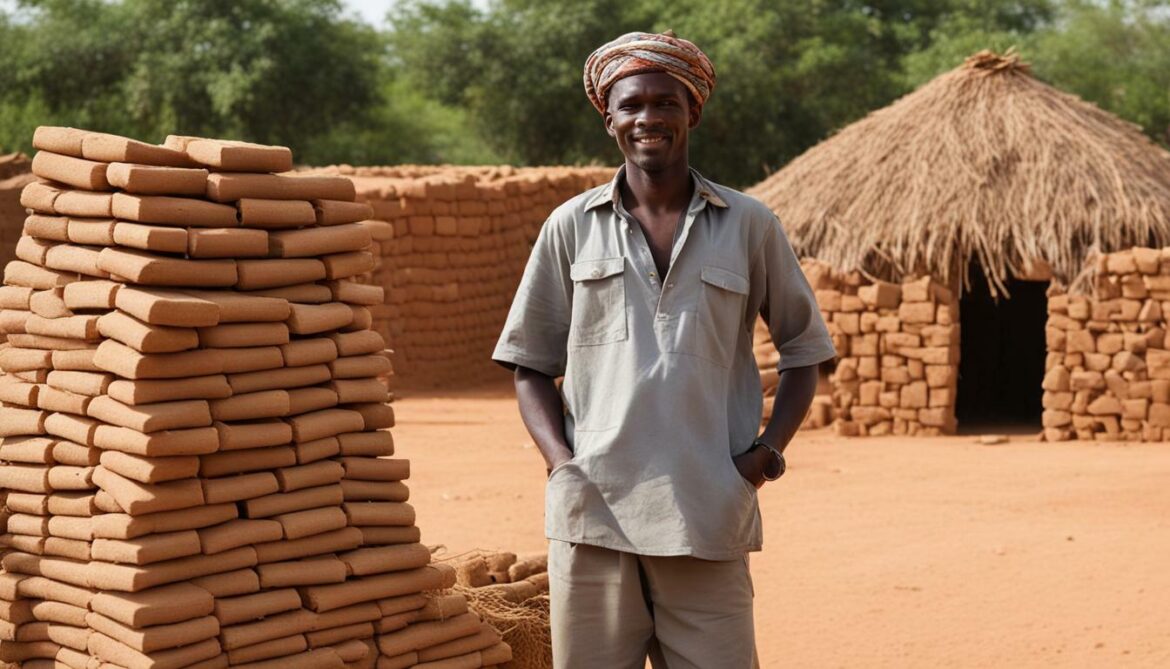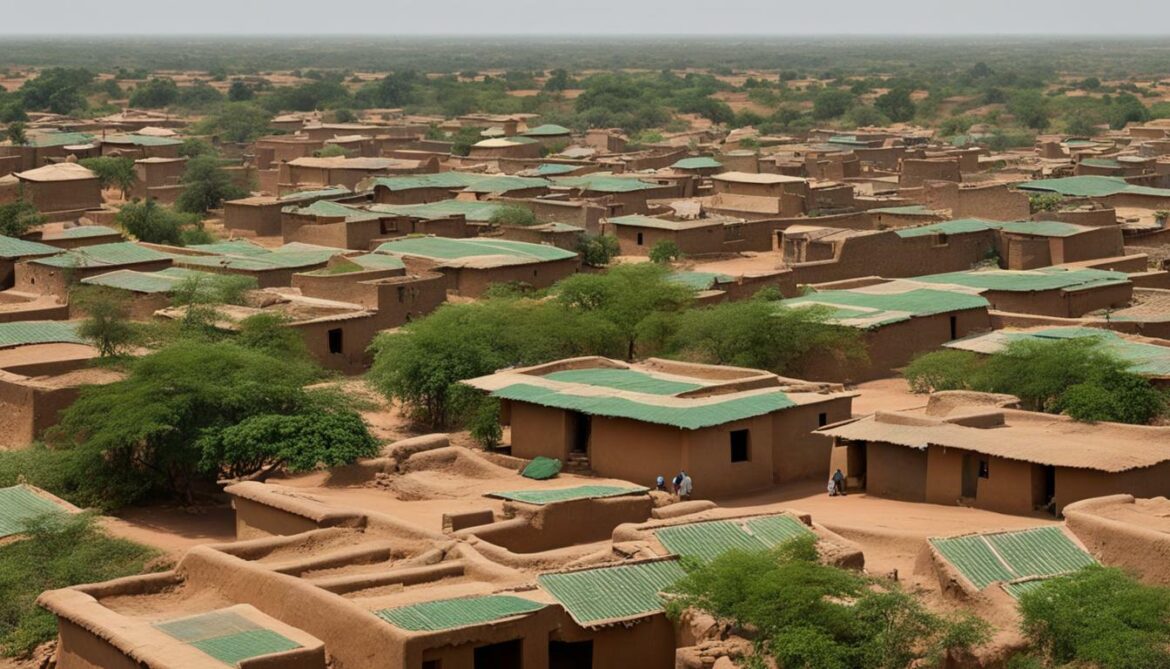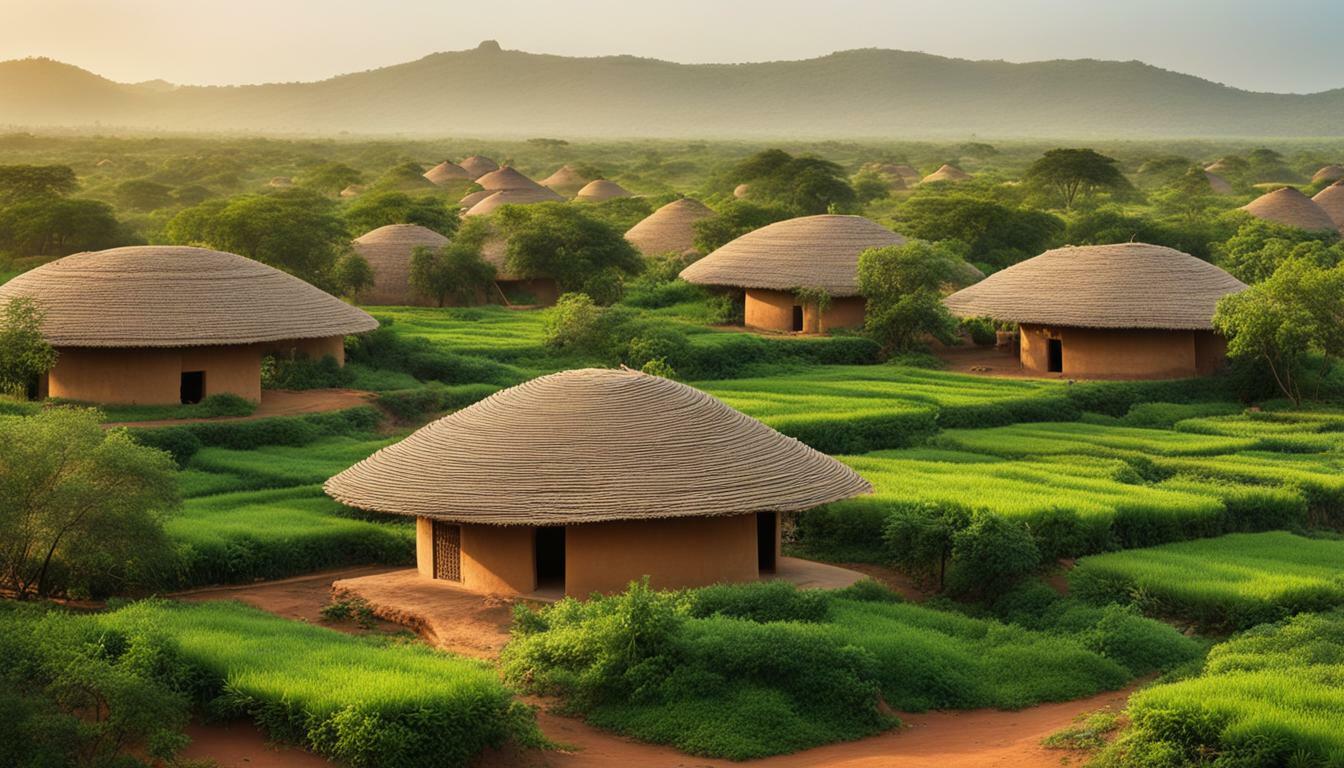Burkina Faso has a long-standing commitment to sustainable construction and environmentally-friendly architecture. The country’s green building history dates back to the 1980s when it faced a shortage of conventional building materials.
In response, architects started using locally-sourced and sustainable materials such as adobe, mud, and straw to build homes and public buildings. These innovative practices led to the development of a unique architectural style that prioritizes sustainability and cultural preservation.
Today, Burkina Faso continues to lead the way in sustainable construction with a range of green building initiatives and sustainable design practices. The country’s commitment to eco-friendly building materials and construction methods has not only reduced its environmental impact but also helped to create jobs and support local economies.
- Burkina Faso has a rich history of sustainable construction and environmentally-friendly architecture.
- The country’s innovative use of locally-sourced and sustainable materials has led to the development of a unique architectural style.
- Today, Burkina Faso continues to lead the way in sustainable construction with a range of green building initiatives and sustainable design practices.
- The country’s commitment to eco-friendly building materials and construction methods has helped to create jobs and support local economies.
- As we move towards a more sustainable future, Burkina Faso’s green building history serves as a valuable example of how innovative and eco-friendly practices can be incorporated into modern-day architecture.
Sustainable Design Practices in Burkina Faso
Burkina Faso has a long history of sustainable building practices, with a focus on eco-friendly design and construction. The country has established several green building initiatives, such as the National Program for the Promotion of Sustainable Construction and Green Spaces, which aims to promote sustainable design practices and reduce the environmental impact of construction.
One of the most notable sustainable design practices in Burkina Faso is the use of traditional African building techniques. These techniques involve constructing buildings using natural materials such as mud, straw, and wood. Not only are these materials readily available and cost-effective, but they also have a minimal impact on the environment.
In addition, Burkina Faso has implemented several modern sustainable design practices, such as passive solar design. Passive solar design involves designing buildings to maximize the use of natural sunlight and minimize the need for artificial lighting and heating. This not only reduces energy consumption but also creates a healthier and more comfortable living environment for occupants.
Another innovative sustainable design practice in Burkina Faso is the use of recycled materials. Builders in the country have found creative ways to repurpose materials such as old tires, plastic bottles, and cans to create building materials. This not only reduces waste but also reduces the need for new resources, making construction more sustainable.
Sustainable Building Initiatives
Burkina Faso has established several sustainable building initiatives to promote environmentally-friendly design practices. One such initiative is the International Festival of Earthen Architecture, which showcases sustainable building techniques and promotes the use of natural materials in construction.
Another initiative is the Green Building Council of Burkina Faso, which promotes sustainable construction practices and provides education and training for builders and architects. The council also certifies green buildings and provides recognition for those who incorporate sustainable design practices into their projects.
The country’s focus on sustainable building has also extended to the education sector, with several universities offering courses in sustainable architecture and design. This helps to ensure that the future generation of architects and builders are equipped with the knowledge and skills necessary to continue implementing sustainable design practices.

“Sustainable design practices in Burkina Faso have not only reduced the environmental impact of construction but have also created a more healthy and comfortable living environment for occupants.”
The history of sustainable building in Burkina Faso is rooted in the country’s commitment to environmentally-friendly architecture and sustainable construction. With ongoing green building initiatives and a focus on sustainable design practices, the future looks promising for Burkina Faso’s eco-friendly construction sector.
Sustainable Design Practices in Burkina Faso
In Burkina Faso, sustainable design practices are an integral component of green building initiatives. Architects and builders have developed a range of innovative eco-friendly construction methods that contribute to sustainable urban development and support the country’s commitment to environmentally-friendly architecture.
One such method is the use of earth bricks as a building material. Earth bricks are made by mixing mud with a stabilizing agent such as cement or lime and compressing it into brick form. Not only are earth bricks an affordable and readily available building material, but they also have a low carbon footprint and offer excellent thermal insulation.

Another eco-friendly construction method used in Burkina Faso is the utilization of clay pots as a form of air conditioning. The pots are stacked on top of each other and covered in wet sand. When the sand is wet, it evaporates, and the evaporation process cools the air inside the pots, which in turn cools the interior of the building. This method is an affordable and sustainable alternative to traditional air conditioning systems.
The history of sustainable building in Burkina Faso is rooted in the country’s economic and social realities. With limited resources and a desire to build in harmony with the natural environment, architects and builders have developed a range of innovative and practical eco-friendly construction methods that support sustainable urban development and offer unique architectural aesthetics.
Sustainable Building Materials in Burkina Faso
One of the key elements of sustainable construction is the use of environmentally-friendly building materials. Burkina Faso has a rich history of utilizing sustainable building materials, many of which have been used for centuries.
One such material is adobe. Adobe is a type of brick made from mud, straw, and water. It is a cost-effective and readily available material that is used extensively in Burkina Faso. Adobe buildings are energy-efficient and can regulate temperature, keeping interiors cool during hot weather.

Beyond adobe, Burkina Faso has also embraced the use of sustainable timber. The country’s forests are under threat from deforestation, which has led to a focus on using sustainably sourced timber in construction projects. Burkina Faso has also explored the use of bamboo as a sustainable building material. Bamboo is a fast-growing and renewable resource that can be used for a variety of construction purposes.
In addition to these traditional materials, Burkina Faso has also experimented with modern sustainable building materials. For example, cement is a commonly used material in construction, but traditional cement production is energy-intensive and produces a significant amount of carbon emissions. In response, Burkina Faso has explored alternative cement production methods that are more environmentally-friendly.
The use of sustainable building materials in Burkina Faso has a long history that is tied to the country’s tradition of eco-friendly construction practices. By continuing to explore and utilize sustainable building materials, Burkina Faso is leading the way in sustainable construction practices in West Africa.
The Future of Green Building in Burkina Faso
As Burkina Faso continues to expand its sustainable construction and environmentally-friendly architecture, the future for green building in the country looks bright. The country has already been recognized for its innovative practices and commitment to sustainability.
With a growing focus on sustainable design practices, Burkina Faso is poised to make even greater strides in the field. The government has launched green building initiatives that encourage the use of eco-friendly construction methods and sustainable building materials. Additionally, the country has implemented policies and regulations that support sustainable urban development.
The use of sustainable building materials in Burkina Faso has been instrumental in reducing the environmental impact of construction projects. Local materials such as mud, straw, and compressed earth blocks have been used in innovative ways to create structures that are both aesthetically pleasing and environmentally sustainable.
Looking ahead, the country has the potential to expand its green building practices beyond its borders. By sharing its knowledge and experience, Burkina Faso can contribute to a more sustainable future for the global construction industry.
Overall, Burkina Faso’s commitment to sustainable construction, environmentally-friendly architecture, and the use of sustainable building materials has positioned it as a leader in the field. With ongoing green building initiatives and a focus on sustainable design practices, the country is poised to make even greater strides towards a more sustainable future.

“The government has launched green building initiatives that encourage the use of eco-friendly construction methods and sustainable building materials.”
Sustainable Building in Burkina Faso: A Promising Future
In conclusion, Burkina Faso has a rich history of sustainable building practices that can serve as a model for other nations. The country’s commitment to eco-friendly construction is evident in its innovative architectural practices, sustainable design initiatives, and use of sustainable building materials.
Looking towards the future, Burkina Faso remains dedicated to expanding its green building sector. The government has implemented various policies and initiatives aimed at promoting sustainable urban development, such as the creation of green spaces in cities and the implementation of energy-efficient building codes.
Furthermore, Burkina Faso is exploring new eco-friendly construction methods that prioritize environmental sustainability while also meeting the demands of a growing population. For example, the country is experimenting with sustainable building designs that incorporate natural ventilation and cooling techniques, reducing the need for air conditioning and other energy-intensive systems.
The Key Takeaways
Overall, the key takeaways from Burkina Faso’s sustainable building history are numerous. The country’s commitment to sustainability has enabled it to create environmentally-friendly buildings that promote the health and wellbeing of its citizens while also preserving natural resources.
By prioritizing sustainable design practices, green building initiatives, and the use of sustainable building materials, Burkina Faso has positioned itself as a leader in the field of eco-friendly construction.
As Burkina Faso continues to expand its green building sector, it serves as an inspiration for other countries seeking to reduce their carbon footprint and promote sustainable development.
FAQ
What is the history of green building in Burkina Faso?
Burkina Faso has a fascinating history of green building practices. The country has long been committed to sustainable construction and has implemented innovative architectural practices that prioritize environmental friendliness.
What are some sustainable design practices in Burkina Faso?
Burkina Faso has implemented various sustainable design practices. These include incorporating natural ventilation and passive cooling techniques, utilizing locally sourced materials, and designing buildings to maximize natural lighting and minimize energy consumption.
What are some eco-friendly construction methods used in Burkina Faso?
Burkina Faso employs a range of eco-friendly construction methods. These include earth construction techniques such as rammed earth and mudbrick construction, as well as using sustainable alternatives to conventional materials, such as bamboo and recycled materials.
What types of sustainable building materials are used in Burkina Faso?
Burkina Faso utilizes a variety of sustainable building materials. These include locally sourced materials like adobe and clay, as well as alternative materials such as bamboo, straw, and recycled materials like tires and bottles.
What does the future hold for green building in Burkina Faso?
Burkina Faso continues to show a strong dedication to sustainable construction. With ongoing green building initiatives and a focus on sustainable design practices, the country is poised for further advancements in environmentally-friendly architecture and a continued commitment to sustainable development.






















Post comments (0)